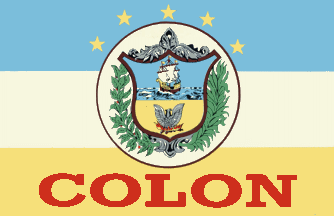
image by Javier Blake, 22 July 2002

Last modified: 2014-05-22 by zoltán horváth
Keywords: panama | colon |
Links: FOTW homepage |
search |
disclaimer and copyright |
write us |
mirrors

image by Javier Blake, 22 July 2002
See also:
The Colón Coat of Arms appears in the middle of the Colón
flag.
Javier Blake, 22 July 2002
An horizontal tricolor of light blue, white and golden welloy,
with a large (diam. approx. half of the flag's height) white disc
rimmed black with the provincial emblem on it; on the blue
stripe, placed around the disc, five five-pointed golden yellow
stars pointing up; and on the yellow stripe the lettering
"COLÓN" in large streched dark red capitals (approx.
face: "Egypitian").
António Martins, 23 July 2002
The provincial flag of Colón was adopted on 16 August 1996 by
the Municipal Council of the District of Colón, presided by
Longino Sánchez. The flag, selected among 28 proposals, was
presented by Alcibíades González on 30 April 1996.
The flag is described as follows:
- upper stripe: light blue (celeste), representing the immense
sea that bathes our coasts;
- middle stripe: white, representing peace and the aspiration of
the inhabitants of Colón to concord with the rest of the
country;
- lower stripe: golden yellow, representing the resources of the
province.
In the middle of the flag is placed the coat of arms of Colón,
adopted by the Municipal Council by Decree No. 37 in 1927 and by
the Provincial administration by Decree No. 1 in 1942.
The coat of arms of Colón is presented on the municipal website
as designed by Carlos Villaláz upon request by Mayor Juan
Demóstenes Arosemena.
The shield is divided per fess. The upper half shows a 15th
century caravel, recalling the discovery of the Americas by
Christopher Colombus. The lower half shows on a golden field a
phoenix bird emerging from flames, as a symbol of eternity. The
shield is flanked by a palm and a laurel branch, symbolizing
progress and triumph, respectively.
The phoenix indeed recalls that the town was burned down and
subsequently rebuilt twice, in 1885 during the Colombian Civil
War, and, accidentally, in 1915.
Source: <www.municipiocolon.gob.pa>.
Valentin Poposki and Ivan Sache, 19 December
2009
colon.jpg)
image contributed by Fred Drews, 12 August 2009
Same coat of arms are used also by the city of Colón.
Fred Drews, 12 August 2009

image by António Martins, 29 May 2003
I found today the website of the Free zone of Colón, Panama,
at www.zolicol.com (defunct) where you may find picture of thezone flag (white
with a logo), near another (unidentified) flag. A question :
should this zone be considered as a subdivision of Panama, or is
it only a body created to administrate as far as business is
concerned a tax-free zone?
The logo can be seen on blue on the web-page.
Olivier Touzeau, 21 March 2001
It is just a tax-free zone.
Juan Manuel Gabino Villascán, 21 March 2001
The "zone flag" is not a flag, but a logo in banner
form. The two blue triangles stand for North and Central
America, with the red triangles at the axis symbolizing the
traffic crossing thorough the Isthmus. The other
(unidentified) flag is a national Panama flag. The logo does not
belong to a territory, but to the administratve body created to
manage the tax-free zone. The logo can be seen on <www.zonalibredecolon.com.pa>.
Alvaro Aguilar, 31 August 2001
The picture sent by Olivier makes it obvious that, unlike
Álvaro Aguilar says, this is a flag. It may not be pretty,
official, registered in the works of famous vexillologists, great
or small - but it is obviously a flag: a piece of cloth hoisted
on pole and meaning something. Álvaro calls it not a flag but
just a "logo in banner form"; well, "banner"
is a trickier word than "flag". While it is surely a
flag, it might be or not a banner...
By using <www.zonalibredecolon.com.pa>,
I created the above image, with shades of blue and red much
darker than those of the Panamian national flag, judging from the
photo (US influence, perhaps?).
António Martins, 29 May 2003